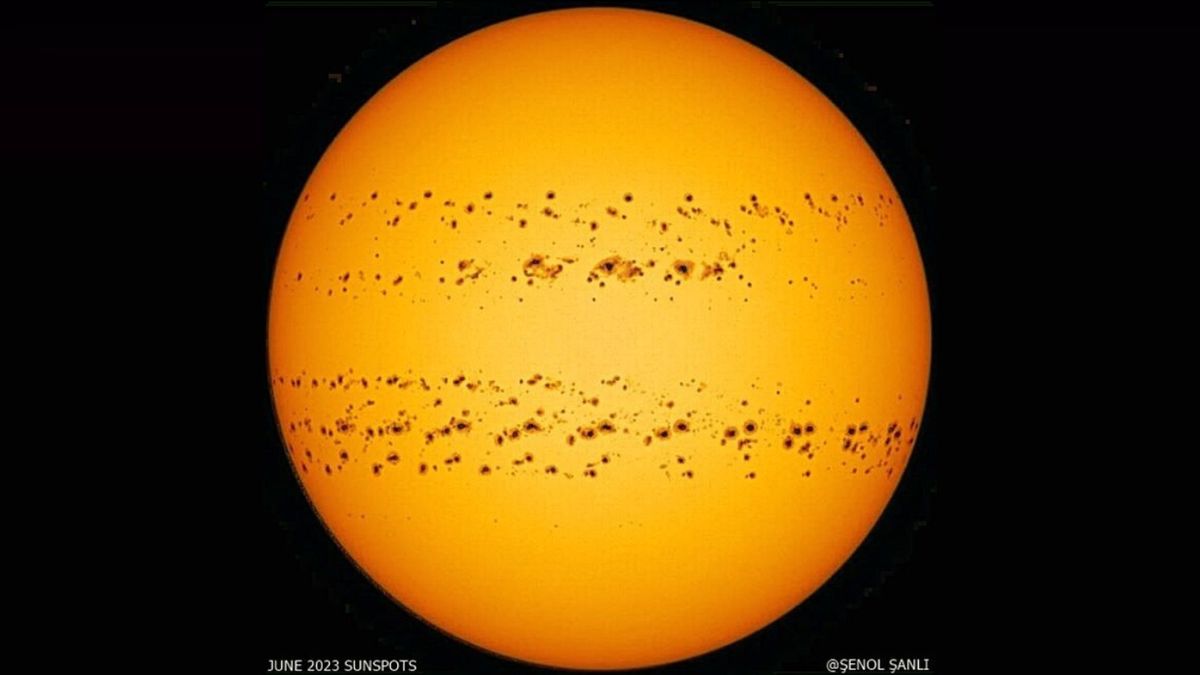The sun is partying like it’s 2002. The number of observed sunspots on our home star last month was the highest for almost 21 years. It’s one of the clearest signs yet we are fast approaching the sun’s chaotic peak, known as solar maximum — and that it will be far more extreme than initially predicted.
In June, 163 sunspots appeared on the solar surface, according to the Space Weather Prediction Center. The last time this many dark patches littered the sun was in September 2002, when 187 sunspots were observed.
Scientists pay particularly close attention to the number of sunspots because it is the easiest way to track changes in solar activity during the sun’s roughly 11-year solar cycle. The dark patches are caused by the sun’s magnetic field poking through the solar surface, which only happens as the field becomes increasingly tangled up with itself as the solar cycle progresses, before eventually flipping completely to kickstart the next cycle.
At the start of each solar cycle when the sun is at its calmest, known as solar minimum, there are almost no sunspots at all. But as the sun approaches solar maximum the number of dark spots sharply rises until the star is covered with them and they begin to spit out increasingly frequent and powerful solar flares.
Related: 10 signs the sun is gearing up for its explosive peak — the solar maximum
The current solar cycle — the 25th scientists have recorded — officially began in December 2019. At the time, scientists predicted the cycle would peak in 2025 and be similar in intensity to the previous cycle, which was meager compared with other cycles on record. However, as Solar Cycle 25 has progressed it has shown signs that it’s far more active than those initial predictions suggested, and experts now believe the upcoming maximum could arrive early and be much more powerful than the last one.
Solar cycle progression
For the last 28 months in a row, the number of observed sunspots has been higher than the predicted values from the initial solar cycle forecasts. For example, the predicted number for June was only 77, which is less than half the actual number of sunspots. And in December 2022, sunspot numbers hit an eight-year high.
June’s sunspot count was greater than any month during the last solar maximum, which suggests the upcoming peak will be much more active. The current trend is more in line with Solar Cycle 23, which peaked between 2000 and 2001. During that solar maximum, the highest sunspot count was 244, recorded in July 2000.
On June 29 this year, a sunspot that had only appeared 48 hours earlier rapidly swelled into a behemoth that was around 10 times wider than Earth, making it one of the largest sunspots of Solar Cycle 25. On July 2, this gigantic dark patch spat out an X-class solar flare (the strongest type the sun can produce), which slammed directly into Earth and caused radio blackouts in the western U.S. and eastern Pacific Ocean. This is another telltale sign that solar maximum is fast approaching and will be more extreme than expected.
But sunspots aren’t the only indicator the upcoming maximum will be stronger than the last. In March, the thermosphere — the second-highest layer of Earth’s atmosphere — reached its highest temperature for almost 20 years after soaking up excess energy from solar storms that hit our planet in early 2023.
Stay connected with us on social media platform for instant update click here to join our Twitter, & Facebook
We are now on Telegram. Click here to join our channel (@TechiUpdate) and stay updated with the latest Technology headlines.
For all the latest For Top Stories News Click Here

